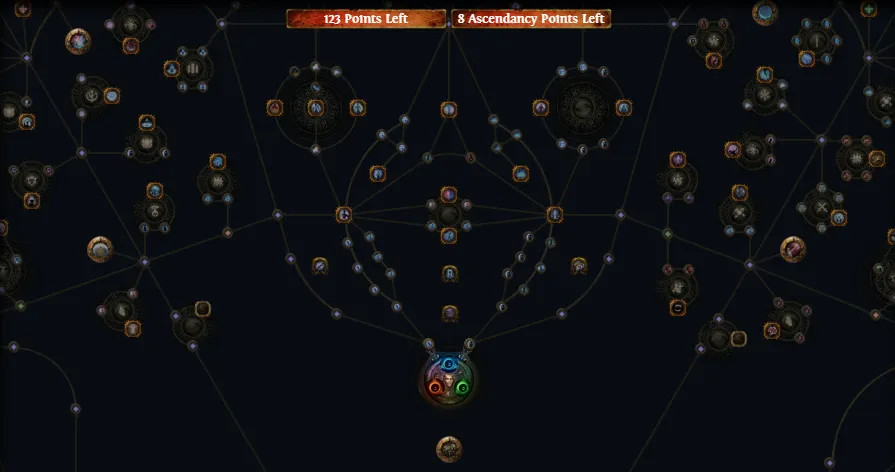PoE Max Skill Points — Path of Exile
In Path of Exile, optimizing your character’s build is all about strategically placing skill points in the massive passive skill tree. Players can accumulate a substantial number of passive skill points through leveling, quests, and even specific in-game decisions. Understanding how to maximize these points and navigate the passive tree efficiently is crucial for creating a powerful character.

PoE Max Skill Points
The PoE Max Skill Points is 123. The Max Ascendancey Points is 8.
Maximum Skill Points Overview
- Passive Skill Points from Levels: Characters can gain up to 99 passive skill points simply by leveling up to the maximum level (100).
- Passive Skill Points from Quests: Throughout the game’s storyline, players can earn 23 passive skill points from completing specific quests. An additional point is available if players choose to kill all the Bandits in Act 2 during the “Deal with the Bandits” quest, bringing the total to 24.
- Total Maximum Skill Points: By combining the points from levels and quests, players can earn up to 123 passive skill points in total.
- Scion Class Additional Points: Players who choose the Scion class have the potential to gain up to 5 extra passive skill points through their Ascendancy choices, which can bring the total to 128 points.
Refund and Respec Points
- Orb of Regret and Refund Points: Players can refund skill points using Orbs of Regret, which allow them to undo a single skill point placement. Additionally, there are 20 passive respec points available from quests, which can be used similarly to Orbs of Regret.
Understanding the Passive Skill Tree Layout
The passive skill tree in Path of Exile can seem daunting at first glance, but it is essentially a map divided into sectors, with each character class starting in a different area:
- Clusters (Suburbs): These are groups of related passive nodes that boost specific stats or abilities (e.g., sword damage, spell power, evasion). These clusters are the core of any build and should align with your character’s strengths and intended playstyle.
- Pathways (Roads): These are the connecting nodes that often provide attribute bonuses (+10 to Strength, Dexterity, or Intelligence). Pathways are essential for moving between clusters, and taking a more direct route via attribute nodes can sometimes be more efficient than detouring through multiple clusters.
Sectors of the Passive Skill Tree
The tree is divided into three primary sectors, each aligned with one of the core attributes — Intelligence, Strength, and Dexterity:
North/Blue Sector (Magic Sector):
- Focuses on Intelligence.
- Contains passives that boost elemental damage, energy shield, minion stats, wand damage, etc.
- Ideal for characters that use magic and intelligence-based skills, such as the Witch.
Southwest/Red Sector (Melee Sector):
- Focuses on Strength.
- Contains passives that boost physical damage, armor, life, and melee combat.
- Ideal for characters focused on melee combat, such as the Marauder.
Southeast/Green Sector (Ranged Sector):
- Focuses on Dexterity.
- Contains passives that boost projectile damage, evasion, attack speed, and ranged combat.
- Ideal for characters focused on ranged attacks, such as the Ranger.
Starting Positions and Character Classes
Each character class starts at a specific point on the inner wheel of the tree, placing them naturally closer to certain types of passives:
- Witch: Starts at the northern edge, in the middle of the blue sector, favoring magic-based passives.
- Marauder: Begins in the middle of the red sector, ideal for melee-oriented builds.
- Ranger: Starts in the middle of the green sector, optimized for ranged combat.
Hybrid classes, such as the Templar or Duelist, start on the borders between sectors, allowing for more flexible builds that can blend attributes from different sectors.
Building Efficiently
While players can technically create any type of build with any class, staying within your character’s natural starting sector tends to be more efficient early on. For example, while you could create a melee-focused Witch, you’d face challenges in acquiring appropriate melee skill gems and would have to travel far across the tree to reach suitable nodes, making it a less efficient build compared to sticking with magic-based skills.
Understanding these dynamics and carefully planning your path through the passive skill tree will ensure that you maximize your character’s potential and create a build that is both powerful and versatile.
Enhance your gameplay experience by purchasing PoE currency. Buy PoE Currency at U4GM with a 6% off coupon “z123”. Happy hunting, Exile!
Similar Posts
- College Football 25 Strategist Archetype
- PoE Kinetic Blast Build 3.25 – Path of Exile: Settlers of Kalguur
- Diablo 4 Aspect of Fel Gluttony
- All Stadiums List in EA SPORTS FC™ 25
- PoE Critical Mastery – Path of Exile
- PoE Disenchanting in the Settlers of Kalguur League 3.25 – Path of Exile
- FC 25 MEWA ARENA Stadium
- PoE Sporebloom Tincture Mods – Path of Exile
- FC 25 LaLiga Hypermotion Stadiums List
- PoE Banner Passive Masteries – Path of Exile
- PoE Dual Strike Build 3.25 – Path of Exile: Settlers of Kalguur
- FC 25 Stoke City FC Stadium
- FC 25 Mercedes-Benz Stadium (Atlanta)
- PoE Armour Mastery – Path of Exile
- PoE Creeping Frost Build 3.25 – Path of Exile: Settlers of Kalguur